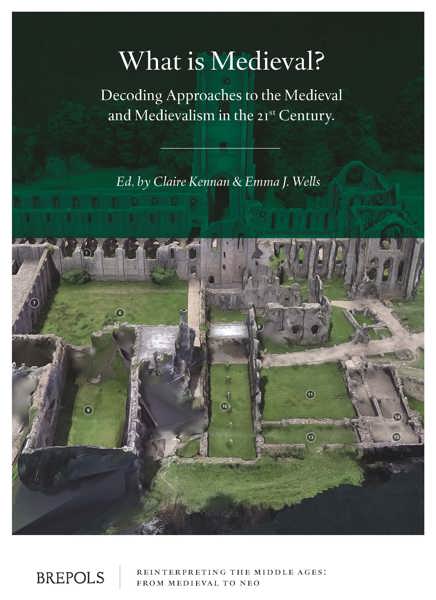
What is Medieval?
Decoding Approaches to the Medieval and Medievalism in the 21st Century
Emma J. Wells, Claire Kennan (eds)
- Pages: 288 p.
- Size:178 x 254 mm
- Illustrations:26 b/w, 24 col.
- Language(s):English
- Publication Year:2024
- € 95,00 EXCL. VAT RETAIL PRICE
- ISBN: 978-2-503-60068-0
- Hardback
- Available
- € 95,00 EXCL. VAT RETAIL PRICE
- ISBN: 978-2-503-60069-7
- E-book
- Available
An examination of medievalism and the medieval in a variety of contexts, from formal learners in the academy to informal learning in schools, museums and at heritage sites, as well as popular culture today and throughout history, and the democratisation of knowledge and image via the internet.
"This volume’s main contribution is its potential to bring together those beyond the academy and those within the academy: its contributors taken together cover a range of life experiences and knowledges, from those who work within secondary education and the heritage sector, in addition to precariously-employed ECRs, as well as more traditionally-employed scholars."
"The essays, (...) contain some genuinely radical and innovative readings of medieval sources and contemporary popular culture." (Reima Välimäki, in H-Soz-Kult, 18/12/2024)
"...[the collection] contains many excellent papers with valuable pedagogical, literary, practical, cultural, and historical insights for medievalists, medievalismists, and teachers of the Middle Ages." (Ellie Crookes, in Sehepunkte, 25(3), 2025)
Emma J. Wells is Lecturer in Ecclesiastical and Architectural History of the Late Medieval and Reformation Era, based at the University of York, and a Research Fellow in Archaeology at Durham University.
Claire Kennan is Lecturer, Research Coordinator and Public Engagement Specialist at the Bader International Study Centre at Herstmonceux Castle, the UK campus for Queen’s University (Canada).
The Middle Ages and Medievalism have been used and abused throughout history–and this continues. This narrative deserves a reassessment. But, what is Medieval? This is the central question that unifies the contributions in this volume.
‘Medievalism’, or the study of the Middle Ages in its broadest sense, refers to the perception, conceptualisation and movement towards the era post the fifteenth century. Its study is therefore not about the period otherwise referred to as the ‘Middle Ages’, but rather the myriad ways it has since been conceived. And the field of medievalism is still in its relative infancy which has led to the emergence of various existential questions about its scope, remit, theoretico-methodological and pedagogical underpinnings, interpretation, periodization, and its relationship to established disciplines and more emerging subdisciplines and specialised fields—both within and without the academy.
In turn, neomedievalism has allowed insight into and a response to the medieval often dominated by the modern. This has provoked debate over the nature of neomedievalism as a discipline, subdiscipline, genre, field or offshoot in direct or contrasting relation to the more traditional medievalism.
Featuring interdisciplinary contributions from academics, educational practitioners as well as museum, digital and heritage professionals, this volume provides a fresh reflection on past methods to emerging pedagogies as well as new avenues of enquiry into the ways we think about the medieval. It is by reconciling these seemingly disparate forms that we can better understand the continual, interconnected, and often politicised, reinvention of the Middle Ages throughout cultures and study.
Introduction: Decoding the Medieval: From Manipulation to 'Other', Emma J. Wells and Claire Kennan
PART 1: Teaching the Medieval
Conquest, Coexistence, and Cultural Exchange on the Silk Road: Reimagining the Medieval World at Key Stage 3, Gemma Plumpton and Dhwani Patel
Encouraging: Secondary-Education Pupils to Take Seriously the Ideas and Cultures of Medieval People, Jonathan Sellin and Jacob Olivey
Pulling Ranks: The Inevitability of the Presentism in Teaching Medievalism, Andrew Elliot and Mike Horswell
Feeling Medieval: Immersive Pedagogy, Ariana Ellis
PART 2: Digitising the Medieval
Getting the Picture: Teaching Modern Medieval Image Theory, Euan Robson
Local History in a Post-digital Landscape: Mining new Pathways through a Triangulation of Digital, Pedagogic, and Research Interests, Jack Newman
Transcending Boundaries for Medieval Studies: Teaching Medieval(isms) via Digital Technologies, Kenna L. Olsen, Cosmo Christoffersen, and Samantha Purchase
Copy, Cut, Paste and Print: Some Design Principles applied to the Book of Kells Memorabilia, Leila Geroto
PART 3: Fetishizing the Medieval
Sexyback Versus Sir Gawain: Getting ‘Medieval'on ‘Sexy’, Kenna L. Olsen
Medieval Kings and Queens: Orientalising Medieval Women on Screen, Meriem Pagès
The King and I: Representations of BDSM in Fanfiction about King Alfred, Martine Mussies
PART 4: Manipulating the Post-Medieval
Arthur's Court and Gothic Spaces in E.L. Hervey's the Feast of Camelot, Renée Ward
Jefferson's Middle Ages: Art, Artifice, Nostalgia, Euan Robson
V IS FOR VIKING, Howard Williams

